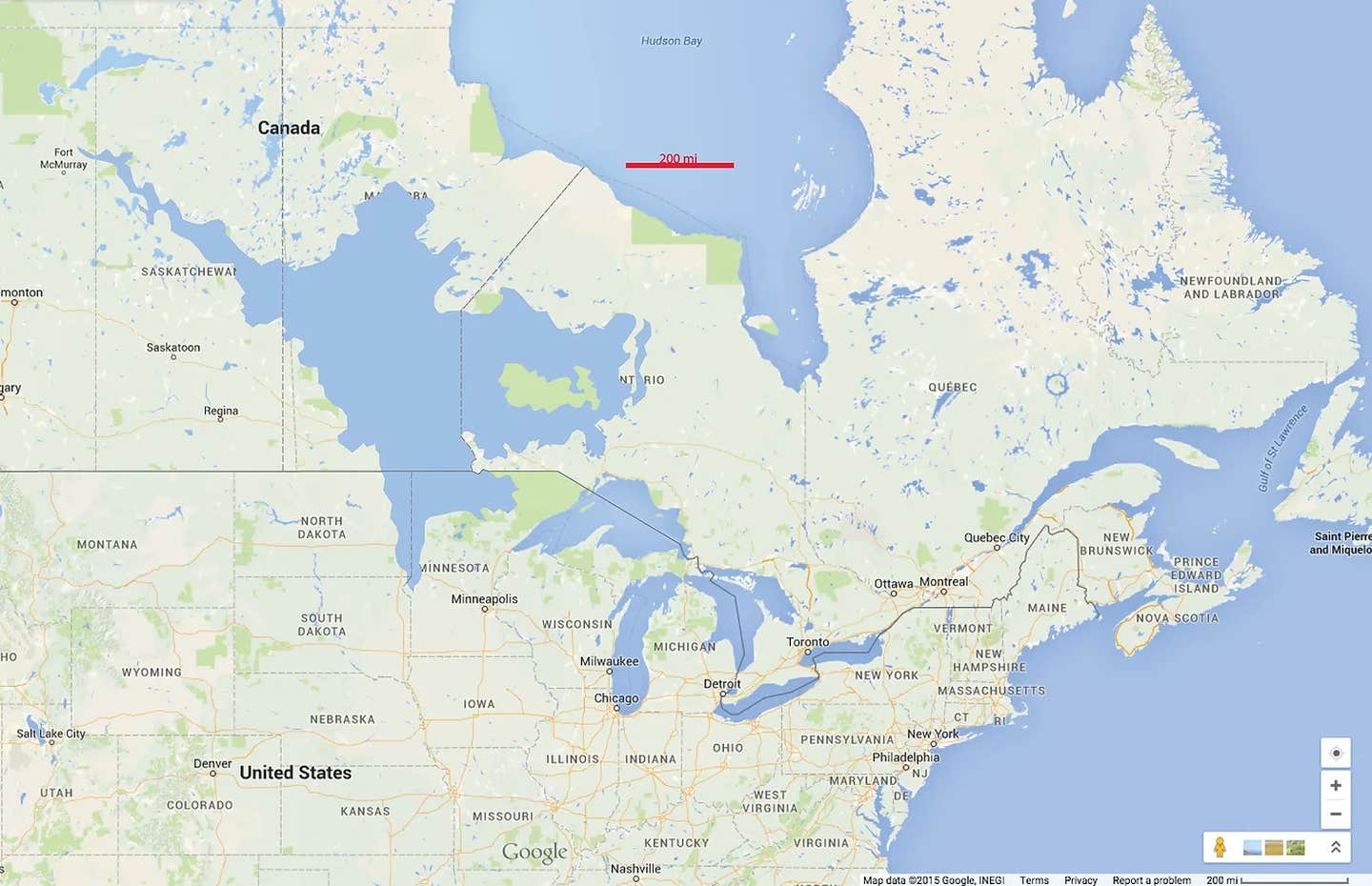Scientists reveal the majesty of North America’s 6th Great Lake
North America boasts five Great Lakes however long before they existed, there was a massive lake that dwarfed them all in size: Lake Agassiz.

Lake Agassiz no longer exists, however, it was one of the largest lakes in North America during the last ice age at an estimated size of around 170,000 square miles. (CREDIT: CC BY-SA 4.0)
North America boasts five Great Lakes namely Huron, Ontario, Michigan, Erie, and Superior. These massive bodies of water are shared borders between several states and Canada. However, long before these Great Lakes existed, there was a massive lake that dwarfed them all in size: Lake Agassiz.
By far, Lake Superior takes the title as the largest of the current Great Lakes with an impressive expanse of 31,699 miles. Lakes Michigan and Huron, which can be considered as one lake since they blend together, cover an area of 45,300 square miles when combined. These massive bodies of water collectively make up the largest freshwater system globally, constituting a staggering 21% of the world’s water resources.
Lake Agassiz no longer exists however it was one of the largest lakes in North America during the last ice age, with an estimated size of around 170,000 square miles. This prehistoric giant, which existed over 10,000 years ago, played a crucial role in shaping the landscape and climate of the continent.
Named after Louis Agassiz, a Swiss-American naturalist who first proposed its existence in the mid-19th century, Lake Agassiz covered much of what is now central Canada and the northern United States. Its basin extended from the Rocky Mountains in the west to the Appalachians in the east, and from the Arctic Ocean in the north to the Gulf of Mexico in the south.
The formation of Lake Agassiz is believed to have been triggered by the retreat of the Laurentide Ice Sheet, which covered much of North America during the last glacial period.
As the ice sheet melted, it created vast amounts of meltwater that flowed into the lowlands of the continent, eventually forming a series of large lakes, including Lake Agassiz.
Over time, Lake Agassiz grew to an immense size, reaching a depth of over 700 feet in some areas. It was fed by numerous rivers and streams, including the Red River of the North, the Minnesota River, and the Winnipeg River. At its peak, it held more water than all of the modern Great Lakes combined.
The vast size of Lake Agassiz had a significant impact on the climate and ecology of North America. Its presence modified the prevailing wind patterns, creating a more humid environment in the surrounding areas. It also affected the distribution of plant and animal species, as well as the migration patterns of early human populations.
Related Stories
One of the most significant events associated with Lake Agassiz was the catastrophic flooding that occurred when its ice dam broke. The ice dam, which formed at the southern end of the lake, was created by the accumulation of glacial ice that prevented the lake from flowing into the Mississippi River.
As the water level in Lake Agassiz rose, the pressure on the ice dam increased. Eventually, the dam gave way, releasing a massive flood that swept across the northern United States and Canada. The floodwaters carved deep channels in the landscape, creating features such as the Grand Coulee and the Columbia River Gorge.
The effects of the Lake Agassiz flood were felt as far south as the Gulf of Mexico, where sediment deposits from the flood were found. The floodwaters also altered the course of several major rivers, including the Missouri and the Mississippi.
Today, Lake Agassiz is no longer visible on the landscape, as it drained completely after the last ice age. However, its legacy can still be seen in the features it left behind, including the Red River Valley and the many lakes and wetlands that dot the region.
Scientists continue to study the history and impact of Lake Agassiz, using a range of tools and techniques to understand this prehistoric giant. One of the most significant recent discoveries has been the use of sediment cores from the lake bed, which provide a detailed record of its history and the environmental conditions of the time.
These sediment cores have revealed a wealth of information about the climate and ecology of North America during the last ice age, as well as the changes that occurred as the ice sheet retreated and the lake drained. They have also provided insights into the evolution of plant and animal species, as well as the movements of early human populations.
The study of Lake Agassiz has also shed light on the broader field of paleoclimatology, which seeks to understand past climate patterns and their impact on the planet. By studying the climate of the past, scientists hope to gain a better understanding of the current and future changes that are occurring, as well as a result of human activity.
One of the key findings from the study of Lake Agassiz is that the climate of North America during the last ice age was much more variable than previously thought. While the prevailing view was that the region was uniformly cold and dry, the sediment cores from Lake Agassiz suggest that there were significant fluctuations in temperature and precipitation.
These fluctuations are thought to have been driven by a range of factors, including changes in ocean circulation, solar activity, and atmospheric circulation patterns. Understanding these factors and their impact on the climate of the past can help scientists better predict and prepare for future climate change.
Another important aspect of the study of Lake Agassiz is its relevance to Indigenous communities in the region. For many Indigenous peoples, the lake and its surroundings hold significant cultural and spiritual importance.
The study of the lake's history and impact can help to deepen our understanding of Indigenous knowledge and perspectives, and to support Indigenous-led research and management of the region.
In recent years, there have been efforts to incorporate Indigenous perspectives and knowledge into the study of Lake Agassiz and its legacy. For example, the University of Manitoba's Centre for Earth Observation Science has partnered with Indigenous communities in the region to develop a shared understanding of the lake's history and significance.
These efforts have also highlighted the need for greater collaboration and engagement between Indigenous and non-Indigenous researchers and stakeholders. By working together, we can gain a more comprehensive and inclusive understanding of the past and present of the region, and work towards a more sustainable and equitable future.
The legacy of Lake Agassiz extends beyond the fields of science and culture, and has important implications for policy and management in the region. The many lakes and wetlands that were formed as a result of the lake's drainage provide important ecosystem services, including water filtration, carbon sequestration, and wildlife habitat.
However, these ecosystems are facing a range of threats, including habitat loss and fragmentation, pollution, and climate change. To protect and restore these ecosystems, there is a need for coordinated and integrated management approaches that take into account the multiple social, economic, and environmental values at stake.
In recent years, there have been efforts to develop such approaches, including the Lake Winnipeg Basin Initiative, a collaborative effort to improve the health and resilience of the lake and its watershed. The initiative brings together Indigenous and non-Indigenous stakeholders from across the region to develop and implement a shared vision for the future of the basin.
Efforts such as these demonstrate the potential for collaborative and integrated approaches to environmental management, and highlight the importance of recognizing and respecting the multiple perspectives and values at play in complex environmental issues.
Lake Agassiz may be a prehistoric giant, but its legacy continues to shape the landscape and people of North America. By studying its history and impact, we can gain a better understanding of the complex and interconnected systems that shape our planet, and work towards a more sustainable and equitable future for all.
Note: Materials provided above by The Brighter Side of News. Content may be edited for style and length.
Like these kind of feel good stories? Get The Brighter Side of News' newsletter.
Joseph Shavit
Head Science News Writer | Communicating Innovation & Discovery
Based in Los Angeles, Joseph Shavit is an accomplished science journalist, head science news writer and co-founder at The Brighter Side of News, where he translates cutting-edge discoveries into compelling stories for a broad audience. With a strong background spanning science, business, product management, media leadership, and entrepreneurship, Joseph brings a unique perspective to science communication. His expertise allows him to uncover the intersection of technological advancements and market potential, shedding light on how groundbreaking research evolves into transformative products and industries.



